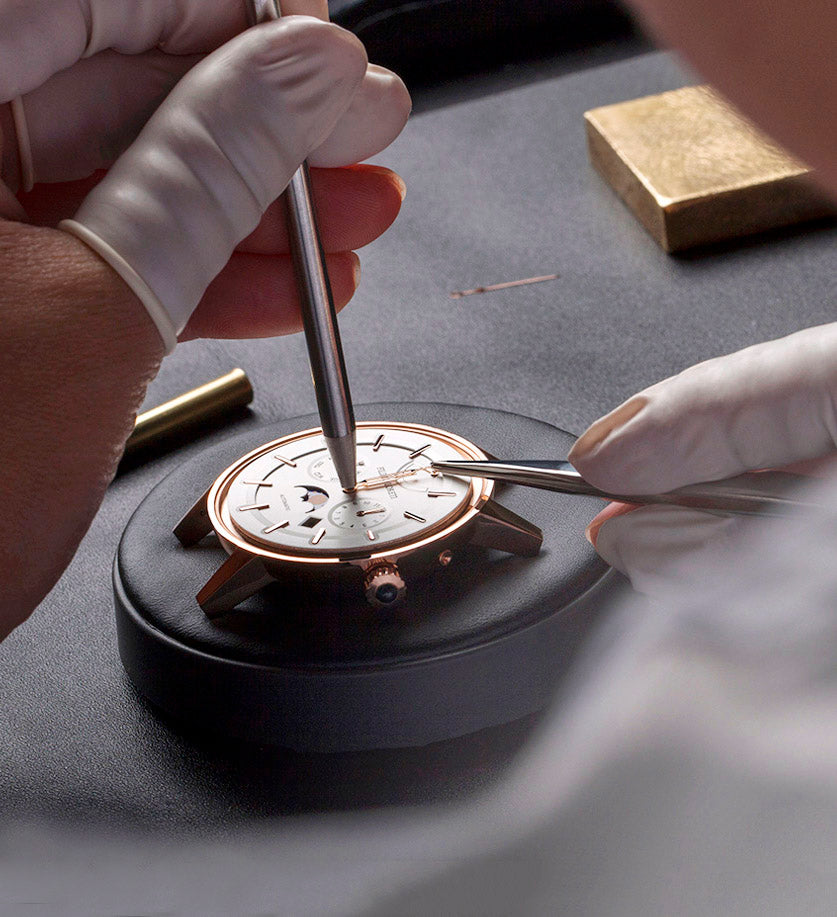Why ‘Swiss made’ watches are not as Swiss as you think

Ah, Switzerland. The name conjures a host of images. The Matterhorn and the Jungfrau. The haunting sound of the Alphorn. Fondue. Chocolate. And, of course… luxury watches. But while the words “Swiss Made” might appear synonymous with “high-quality”, in the premium watch market, the reality isn’t quite what it seems.

What Does ‘Swiss Made’ Actually Mean?
The Alpine nation boasts a long and world-renowned tradition of watchmaking, rich with romantic associations. But it’s a history many manufacturers are keen to exploit. So before you assume every “Swiss Made” watch has been lovingly handcrafted by a family of watchmakers in Geneva, it’s time to look at the facts.
According to the Swiss watch industry’s governing body (i.e. FH), to qualify for the label “Swiss Made”, 60% of a watch’s production costs must be Swiss-based. Dig a little deeper, and you’ll discover only 50% of the parts used in a watch’s movement (by value, rather than quantity) must be Swiss.
It seems the Swiss watch industry’s 40-year-old regulations contain more holes than the nation’s famous cheese. In some instances, 100% of the watch’s case, dial, hands, and the strap may be imported — but as long as 50% of the movement is made in Switzerland, a watch can still be labeled “Swiss Made.”
Let’s say you buy a “Swiss Made” watch from a premium brand that uses a movement from a mass production-oriented factory based in Switzerland, and the “makers” of both the movement and the watch have followed Swiss regulations and optimized their production costs. While that timepiece may claim to be of Swiss origin, almost two-thirds of it has been produced outside of Switzerland.

Quel Fromage!
It’s a situation that’s even getting some of Switzerland’s high-end makers hot under the collar. Ultra-luxury brand H. Moser & Cie, whose watches are 95% made in Switzerland and retail for $30,000 USD or more, created a bizarre million-dollar one-off watch in protest of the country’s loose regulations. Unlike many watches that satisfy the “Swiss Made” criteria, Moser’s “Swiss Mad” model was “100% Swiss” — its case was made from Switzerland’s celebrated Vacherin Mont d’Or cheese, encased in resin, and mounted on a Swiss cowhide strap.
So, aside from getting high-end watchmakers (and, presumably, dairy farmers) riled up, does any of this matter? In a word, yes. Because it doesn’t take a watch made from cheese to see that something about the “Swiss Made” designation stinks. In fact, H. Moser & Cie is so incensed that many “Swiss Made” watches are nothing of the kind, it has vowed to remove the description from its own watches going forward.
Double The Money
While buyers of many “Swiss Made” watches aren’t getting the genuine article, they’re certainly paying for it. Although a “Swiss Made” watch may contain a movement that’s up to 50% sourced from international suppliers, a 2016 study by the University of S.t Gallen found consumers were willing to pay up to twice as much for a watch bearing the inscription compared to a comparable watch made elsewhere. That’s a lot of money for two little words.
One reason for the inflated price is that watches labeled as “Swiss Made” are assembled in Switzerland, where production costs are sky-high. So while affordable brands piggyback on the reputation of the country’s most reputable manufacturers, the reality is that buying “Swiss” may mean you get less for your money.

World-class Watches
So what’s the alternative? We understand that informed consumers aren’t fooled by misleading labels. What matters to us is quality and service. Our unique business model ensures we can deliver both at an affordable price.
As with many industries, watch manufacturing has changed with the times. Like our competitors who offer “Swiss Made” watches, we source many of the precision components used in Filippo Loreti watches from China. Unlike our competitors, we don’t ask you to pay a premium for two little words. We don’t believe the “Swiss Made” designation is worth the overpriced timepiece it’s written on.

Filippo Loreti watches are assembled to our exacting standards at state-of-the-art manufacturing facilities in the global technology hub of Shenzhen province, Hong Kong — manufacturing home of the Apple iPhone, among other premium products. We select components that offer an unrivaled combination of quality and value — from the luxurious Italian leather of our straps to our tried-and-tested Japanese Miyota movements, renowned in watchmaking circles for their reliability.

The Essence Of Quality
Bypassing the unnecessary expense related to the “Swiss Made” moniker allows Filippo Loreti to deliver high quality, state-of-the-art technology, without an inflated price tag. It also means we can afford to bring you the level of customer service you expect from a premium brand, but which few so-called “affordable” brands deliver.
Don’t get us wrong: Switzerland is the birthplace of some of the most fabulous timepieces ever to have graced the world’s wrists. But you don’t need to spend a five-figure sum to get a truly unique and high-quality timepiece. As many smart buyers are beginning to realize, the “Swiss Made” designation on the dial of a watch isn’t the passport to luxury you might expect.
Like they say, you shouldn’t take everything at face value.